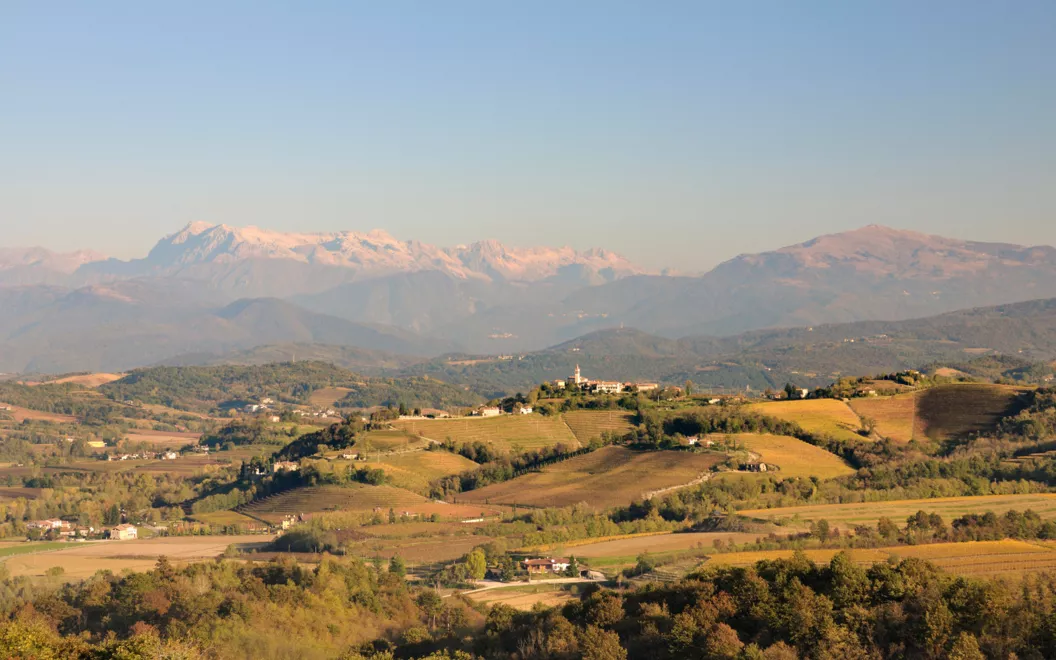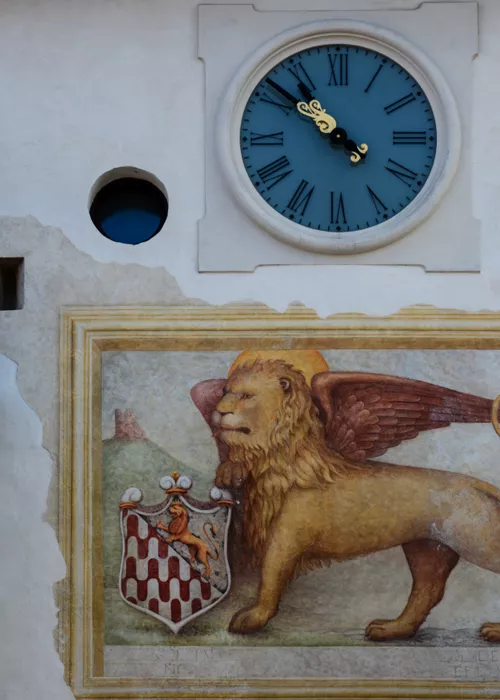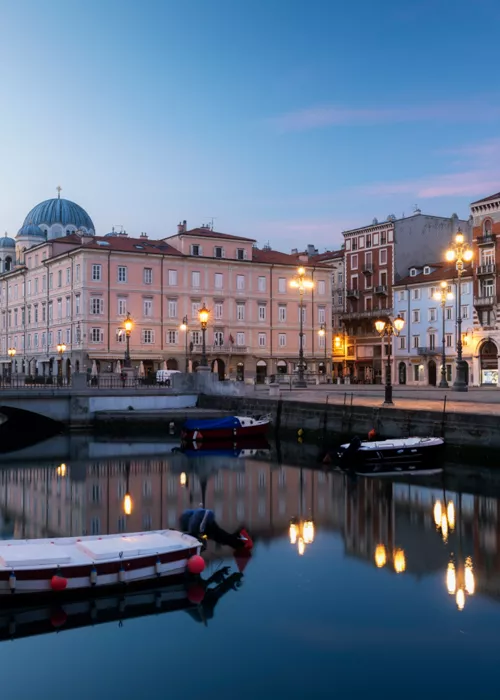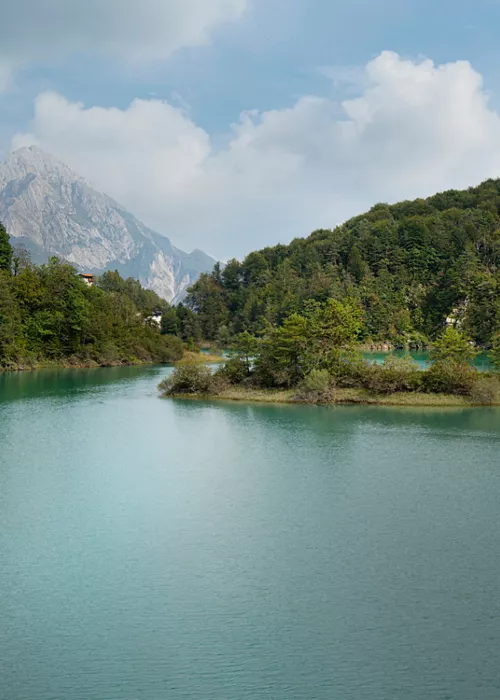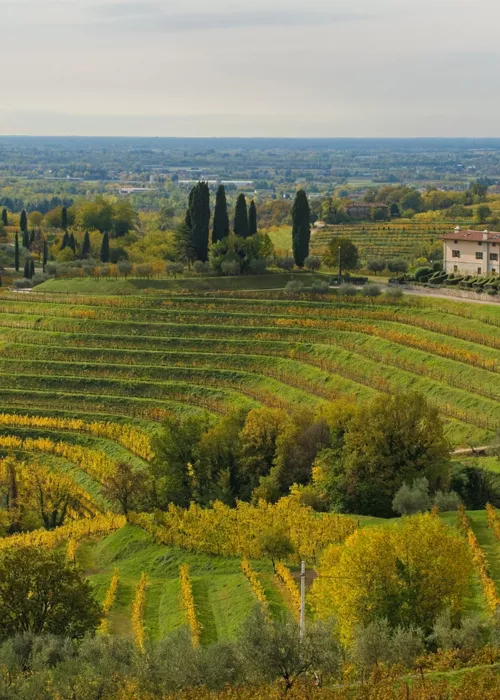Dolegna del Collio

Following the shape of a crescent that embraces, without ever crossing it, the Slovenian border, travellers can begin their visit of the Collio Goriziano starting from its northern end, Dolegna del Collio.
Wedged in a narrow strip of land between the course of the Judrio stream, which separates it from the province of Udine, and the Slovenian border, Dolegna del Collio offers glimpses of lush nature, largely shaped by man.
The tourist road 'of wine and cherries', which since 1963 has promoted the food and wine tourism of the Collio Goriziano, crosses some amazingly picturesque views right around Dolegna del Collio.
The typical scenery of vines, punctuated by rural stone houses and cherry trees, characterises the landscape. Every now and then, the pointed silhouette of some country bell towers pops up, such as that of the church of S. Leonardo in the hamlet of Scriò, frescoed at the end of the 19th century by Giacomo Meneghini, better known in Friuli as Jàcun Pitôr.
Nature becomes wilder and more uncultivated when, descending from Dolegna del Collio towards Cormòns, you encounter the dense vegetation of the Plessiva forest. Foxes, roe deer and hares populate this forest, made green by the foliage of chestnut, oak and locust trees, while hawks and buzzards circle the sky.
Among the rural streets of Dolegna del Collio you can include a taste of Collio Doc, a registered designation of origin since 1968. Among the many varieties of fine wine bottled in these parts, the Collio Bianco grape stands out, with its fresh, lively flavour and delicate, slightly aromatic aroma, the pride of many small local producers.
Cormòns

Among the hills of the Collio Goriziano, different historical and cultural identities coexist harmoniously, and this is even more evident when visiting Cormòns, in the centre of a large territory dotted with tiny and bucolic countryside towns, such as that of Giassico, a rural village with ancient charm.
The main urban settlement of the Collio goriziano, the town of Cormòns clusters around the Domo di S. Adalberto, surrounded by an unmistakable forest of red roofs protecting the façades of the medieval buildings.
Leaving the cathedral, it takes only a few steps to reach Piazza XXIV Maggio, the city's living room; just beyond it is Piazza della Libertà, where a statue of Maximilian I, the founder of the Habsburg dynasty, stands out.
The historical link of Cormòns with Austrian domination is still strong: between the 17th and 18th centuries, the Habsburgs embellished the village with elegant buildings in a typically Austrian style, such as Palazzo Waiz del Mestri and Palazzo Locatelli. The latter is now the town hall and houses the Museo civico del territorio, a reference point for in-depth study of the historical and cultural heritage of the Collio goriziano area.
Known as a centre for the production of chairs and furniture, Cormòns is often associated with the massive cultivation of vines, which is organised here around a single cooperative, but the culinary products on sale in the village shops, such as the famous ham smoked with cherry and laurel wood or the dairy cheeses, are no less important. Several local recipes combine the best of Friulian cuisine with Central European traditions: think of tasty dishes such as goulash, of Hungarian origin and similar to a meat stew, and blecs, homemade pasta cut into strips. There are also meat and vegetable soups, such as jota, made with potatoes, beans, pork rind and sauerkraut.
Before leaving Cormòns, it is advisable to ascend the road to the summit of Mount Quarin, amidst vineyards, olive groves and fruit trees, to observe a breathtaking panorama of the entire surrounding area from its 274 metres of altitude. Alternatively, for an equally memorable view of the Collio goriziano, you can drive towards the church of San Giorgio in the hamlet of Brazzano: from here, on a clear day, the view extends as far as the Trieste Karst and the Adriatic Sea.
Capriva del Friuli

As already noted in Cormòns, the oldest nucleus of Capriva del Friuli has a small group of houses huddled around the village's main place of worship, the Church of the Most Holy Name of Mary, whose bell tower was used as a watchtower. Destroyed and rebuilt several times in different styles, the current appearance of the church dates back to the 19th century.
The name of the village of Capriva del Friuli may derive from the Slovenian word for nettle plant (kopriva): it seems that when the Slavic peoples occupied this territory in the Middle Ages, the fields were covered with large expanses of nettles. Today, after centuries of interventions and reclamation, the surrounding landscape instead boasts the picturesque geometries of vineyards designed by generations of winegrowers.
Speaking of wine again, as is inevitable during a trip to the Gorizia Collio, Capriva del Friuli's recent food and wine past is linked to an estate located on the slopes of the Russiz hill. Amongst these rows of vines, dominated by a white neo-Gothic villa, completed in 1872, lived the noblewoman Elvine Ritter de Zahony and her husband Theodor de la Tour, to whom we owe the introduction of typically French vines in the Collio goriziano, such as Sauvignon and Chardonnay.
The wine produced in Russiz by Count de la Tour was a great success among members of the European aristocracy and even today villa Russiz is among the most prestigious farms in the area, open for tastings and purchases. Elvine's devotion to Theodor was such that when he died in 1894, the countess chose the highest point of the estate to have a mausoleum dedicated to her husband built, which can be visited on request.
A few steps away from Villa Russiz, the equally bucolic and evocative scenery of an Italian garden enriches the landscape around the Castle of Spessa: the Venetian writer and poet Giacomo Casanova, known for his dynamic sentimental life, and Lorenzo Da Ponte, librettist of three works by Wolfgang Amadeus Mozart, stayed in this elegant residence.
San Floriano del Collio

About ten kilometres down the road from Capriva del Friuli lies the compact historic centre of San Floriano del Collio, located just a few metres from the border between Italy and Slovenia.
A picturesque village of medieval origin, partially destroyed during the First World War, San Floriano del Collio dominates the province of Gorizia from the top of a hillock, at 276 metres above sea level.. From here, there are panoramic views of the Julian Alps and the plain carved out by the Isonzo River, which stretches as far as the Adriatic Sea.
The Formentini and Coronini-Tacco castles, also severely damaged by the battles of the 20th century, are the town's main monuments and are now home to two renowned farms.
A visit to San Floriano del Collio could be an opportunity to delve into the local food and wine tradition once again. Gorizia's DOC wines are also confirmed here in terms of quality and variety: an important role in the success of the products is to be attributed to the local soil, known as flysch or ponca, a sandstone rich in limestone, potassium and phosphorous, capable of giving the grapes pleasant aromas.
To accompany the wines of San Floriano del Collio, one could try a slice of bread topped with pestàt, a cream made from herbs and lard, or the tasty brovada, a mixture of red turnips macerated in marc, the skins and seeds of black grapes left over after pressing.
Oslavia Military Memorial

At the eastern end of the horseshoe that the territory of the Gorizia Collio draws around the Slovenian border is the small town of Oslavia, a hamlet of the city of Gorizia, a few steps from the Isonzo river.
The echoes of recent history, already found several times during this itinerary through vineyards and villages, are even more evident and visible at Oslavia. In fact, some of the bloodiest battles of the First World War were fought around Gorizia.
The Italian army, in the course of twelve offensives between 1915 and 1917, attempted to reconquer the Friulian territory from the hands of the Austro-Hungarian Empire, an ally of Germany: the consequences in terms of casualties, displaced persons and damage were disastrous.
Around Oslavia in particular, the Fourth Battle of the Isonzo was fought between November and December 1915; the names of some small localities, such as Tre Buchi, Lenzuolo Bianco and Dosso del Bosniaco, bear witness to the war memory of these lands.
In memory of those who fell in the war stands the mighty white structure of the Military Shrine of Oslavia, an ossuary that holds the bodies of tens of thousands of soldiers. A steep flight of steps, bordered by tall cypress trees, ends in front of a solemn circular building, designed by architect Ghino Venturi and completed in 1938.


